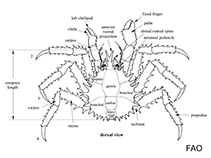Lithodes aequispinus Benedict, 1895
Golden king crab| Native range | All suitable habitat | Point map | Year 2050 |

|
| This map was computer-generated and has not yet been reviewed. |
| Lithodes aequispinus AquaMaps Data sources: GBIF OBIS |
Hochladen Photos
Google Bild | No image available for this species;
drawing shows typical species in Lithodidae.
Google Bild | No image available for this species;
drawing shows typical species in Lithodidae.
Classification / Names Common names | Synonyms | CoL | ITIS | WoRMS
| Decapoda | Lithodidae | Lithodinae
Environment: milieu / climate zone / depth range / distribution range Ökologie
; tiefenbereich 160 - 1347 m (Ref. 101275). Temperate, preferred 7°C (Ref. 107945); 62°N - 35°N, 138°E - 131°W
Verbreitung Länder | FAO Gebiete | Ecosystems | Vorkommen | Einführungen
Northern Pacific: from Shizuoka, Japan to Kamchatka Krai, Russia, east to Vancouver, Canada.
Length at first maturity / Size / Gewicht / Alter
Maturity: Lm ? range ? - ? cm Max length : 3.9 cm CL Männchen/unbestimmt; (Ref. 101431)
Life cycle and mating behavior Geschlechtsreife | Fortpflanzung | Ablaichen | Eier | Fecundity | Larven
Members of the order Decapoda are mostly gonochoric. Mating behavior: Precopulatory courtship ritual is common (through olfactory and tactile cues); usually indirect sperm transfer.
Hauptreferenz
Referenzen | Koordinator | Partner
Bisby, F.A., M.A. Ruggiero, K.L. Wilson, M. Cachuela-Palacio, S.W. Kimani, Y.R. Roskov, A. Soulier-Perkins and J. van Hertum. 2005. (Ref. 19)
IUCN Rote Liste Status (Ref. 130435)
CITES Status (Ref. 108899)
Not Evaluated
CMS (Ref. 116361)
Not Evaluated
Bedrohung für Menschen
Nutzung durch Menschen
Fischereien: kommerziell
| FishSource | Sea Around Us
Tools
Mehr Information
Internet Quellen
BHL | BOLD Systems | CISTI | DiscoverLife | FAO(Publication : search) | Fishipedia | GenBank (Genom, nucleotide) | GloBI | Gomexsi | Google Books | Google Scholar | Google | PubMed | Tree of Life | Wikipedia (Gehe zu, Suchen) | Zoological Record
Estimates based on models
Preferred temperature
(Ref. 115969): 0.4 - 4.6, mean 2.5 (based on 146 cells).
Widerstandsfähigkeit
(Ref. 69278):
niedrig, Verdopplung der Population dauert 4,5 - 14 Jahre. (K=0.07-0.13).
Nutrients: Calcium = 109 [35, 184] mg/100g; Iron = 1.59 [1.21, 1.97] mg/100g; Protein = 20.2 [19.2, 21.3] %; Omega3 = 0.285 [0.185, 0.386] g/100g; Selenium = 48.3 [-31.7, 128.3] μg/100g; VitaminA = 0 μg/100g; Zinc = 1.79 [1.17, 2.40] mg/100g (wet weight).



